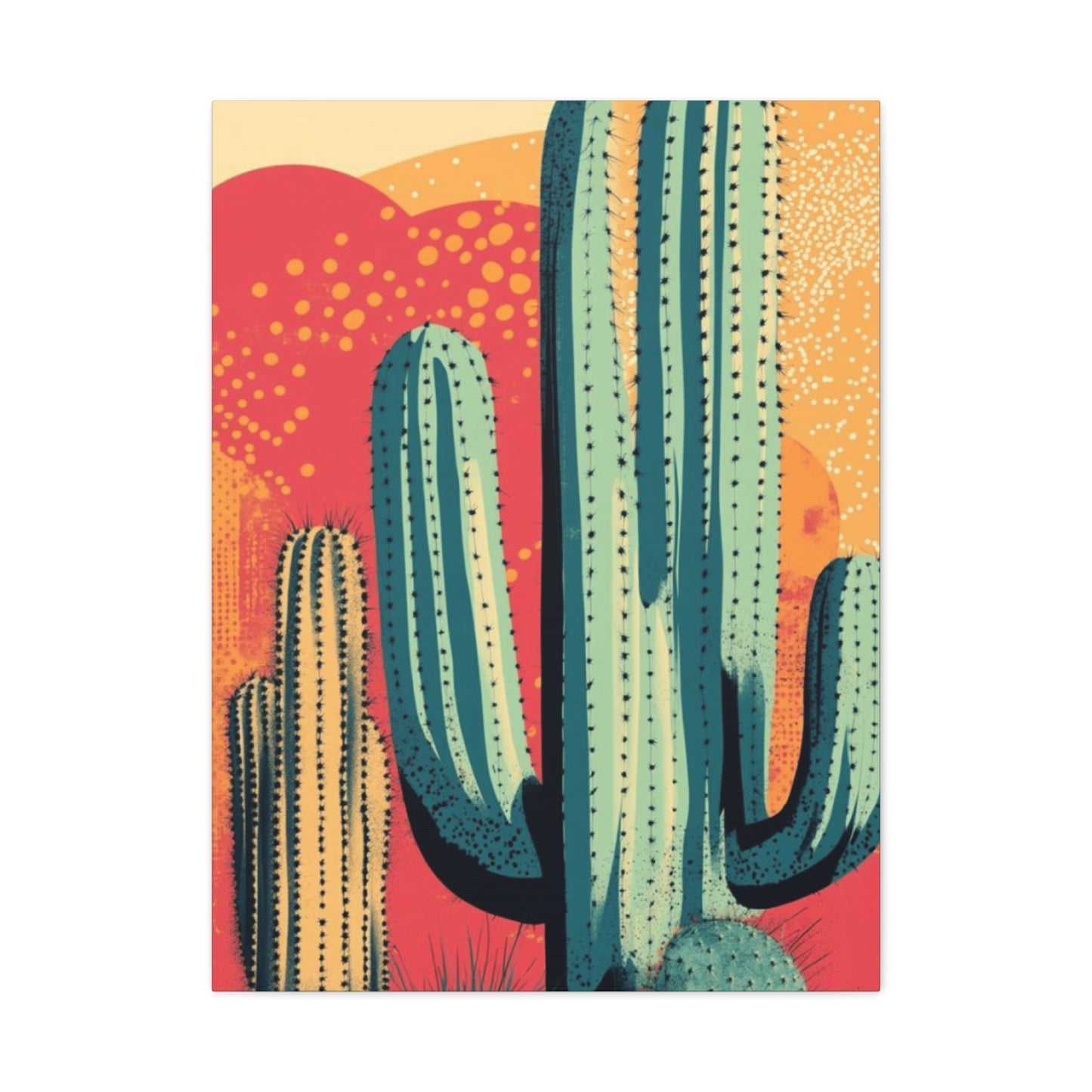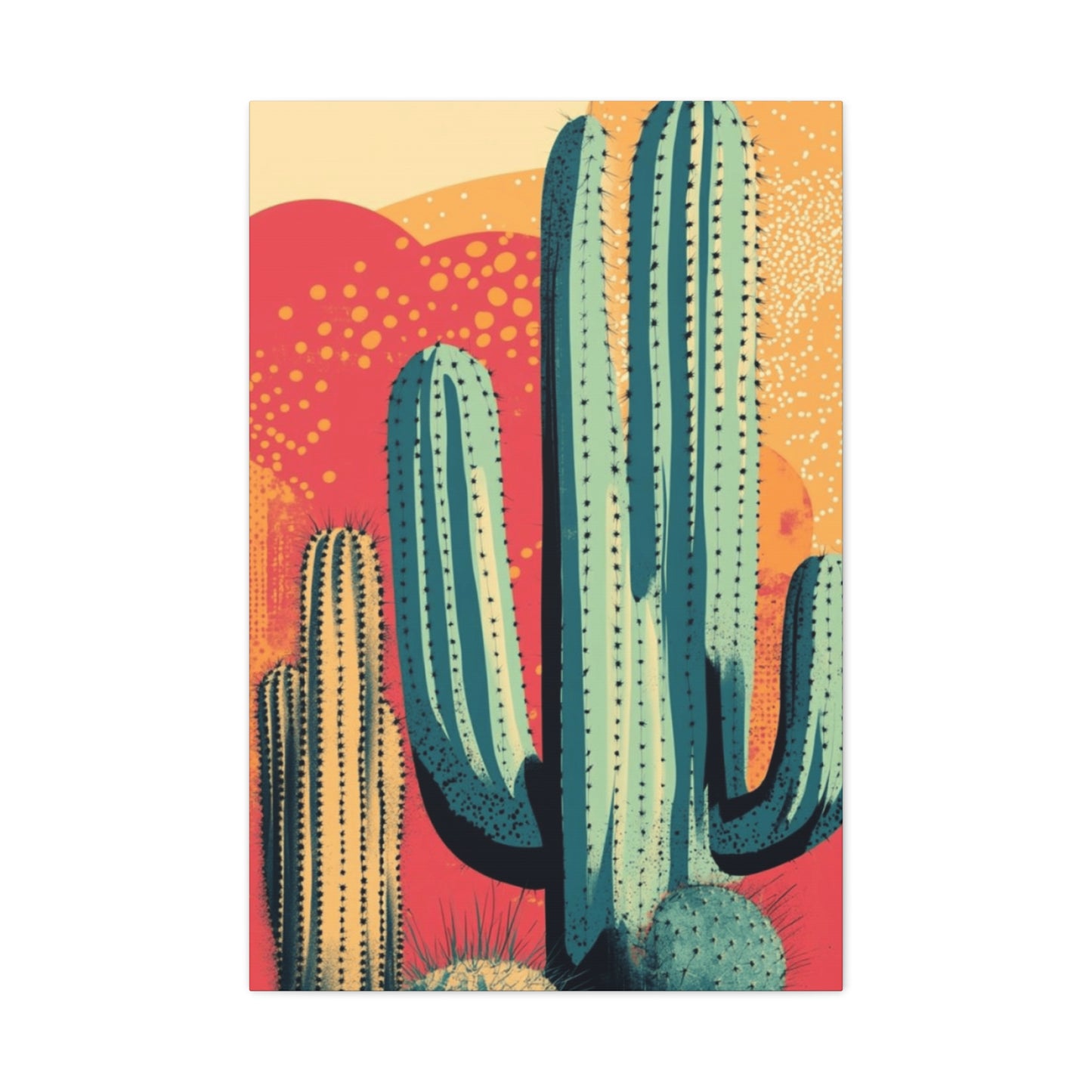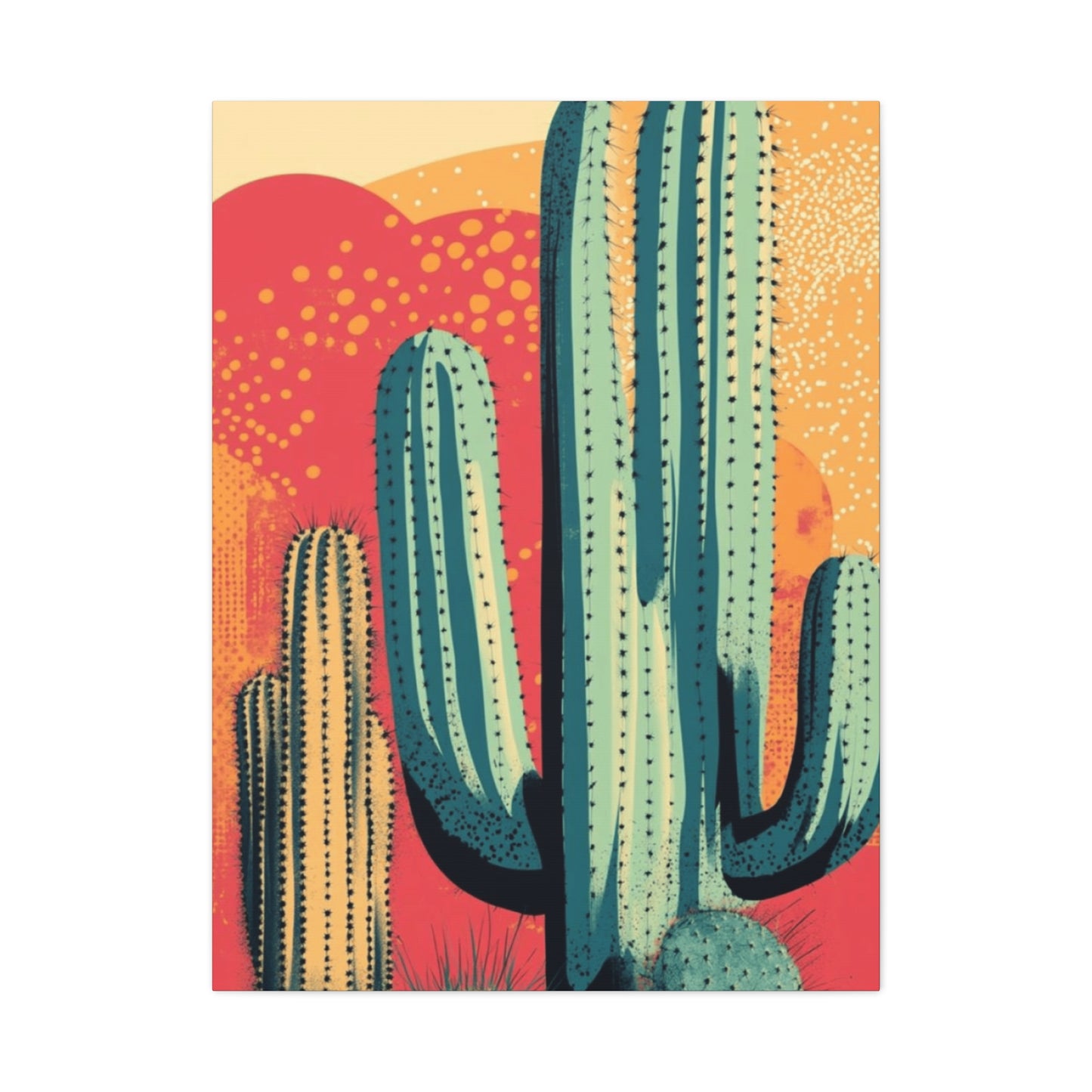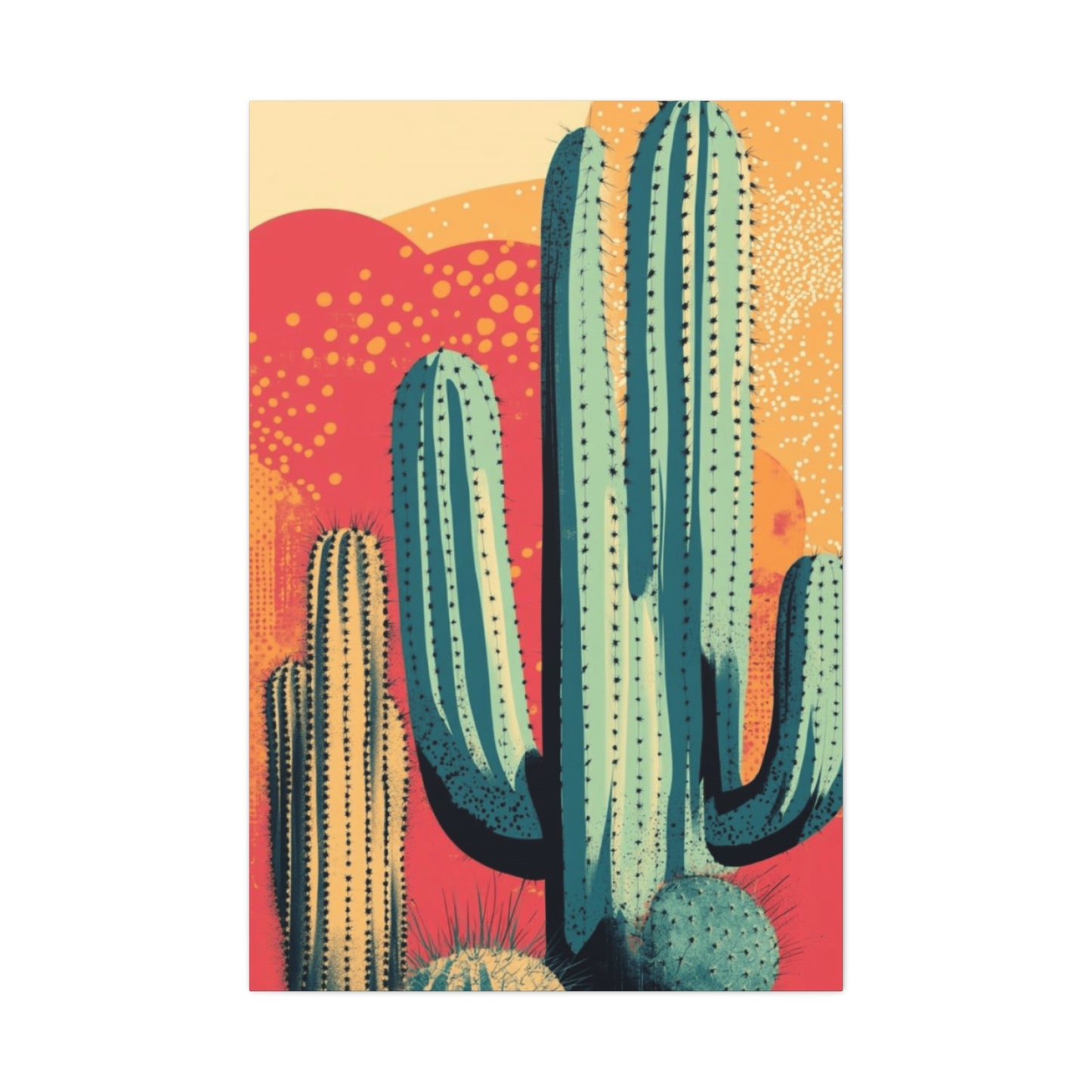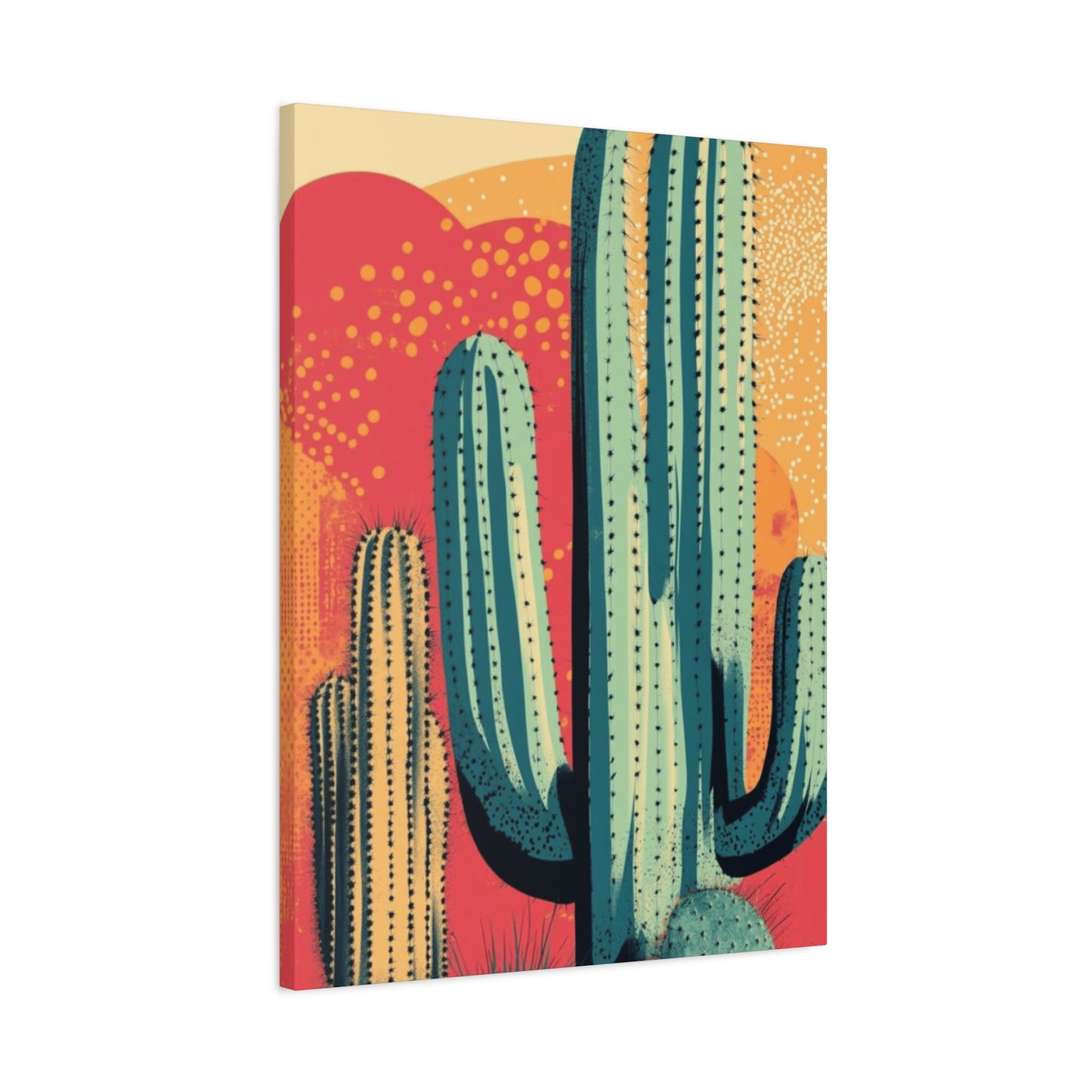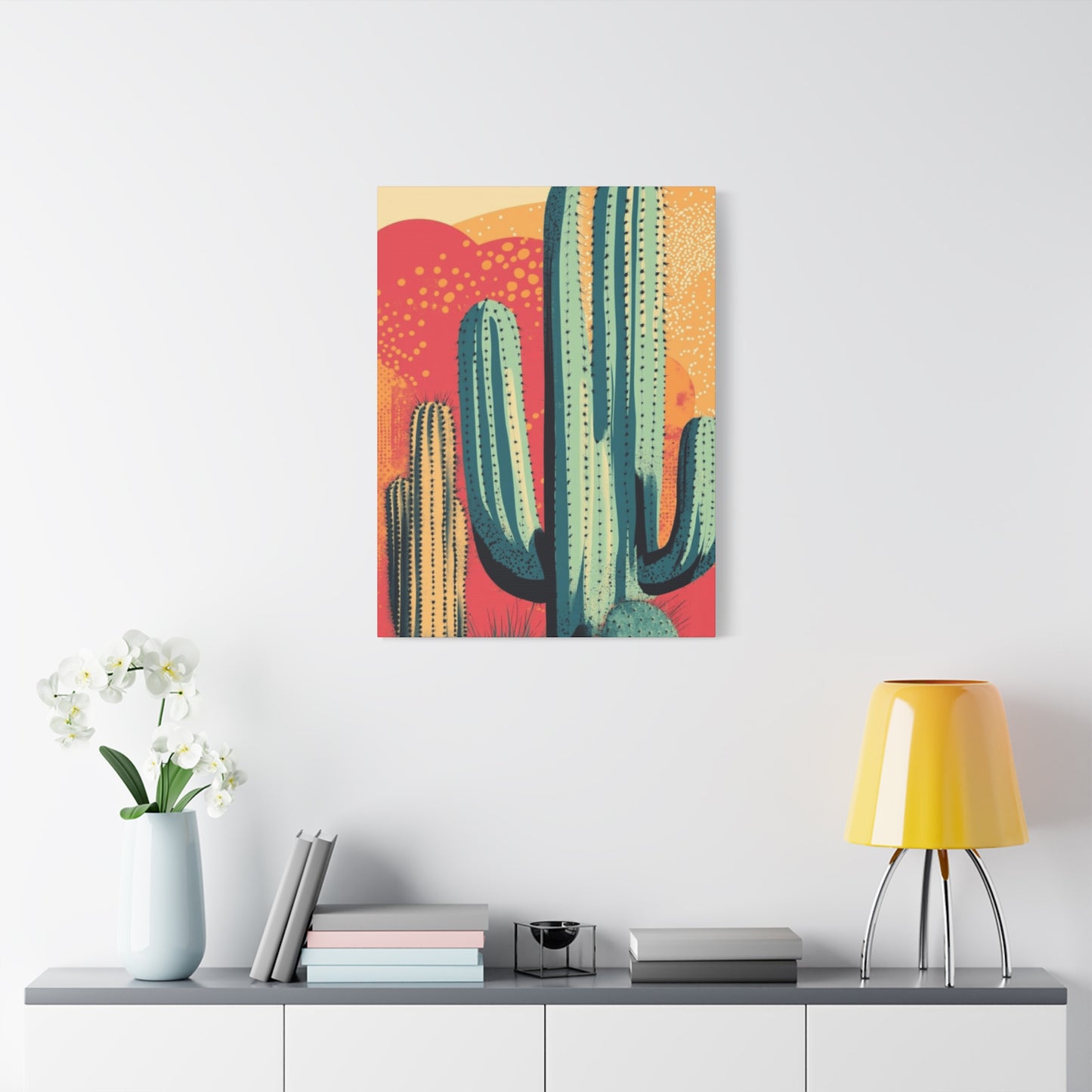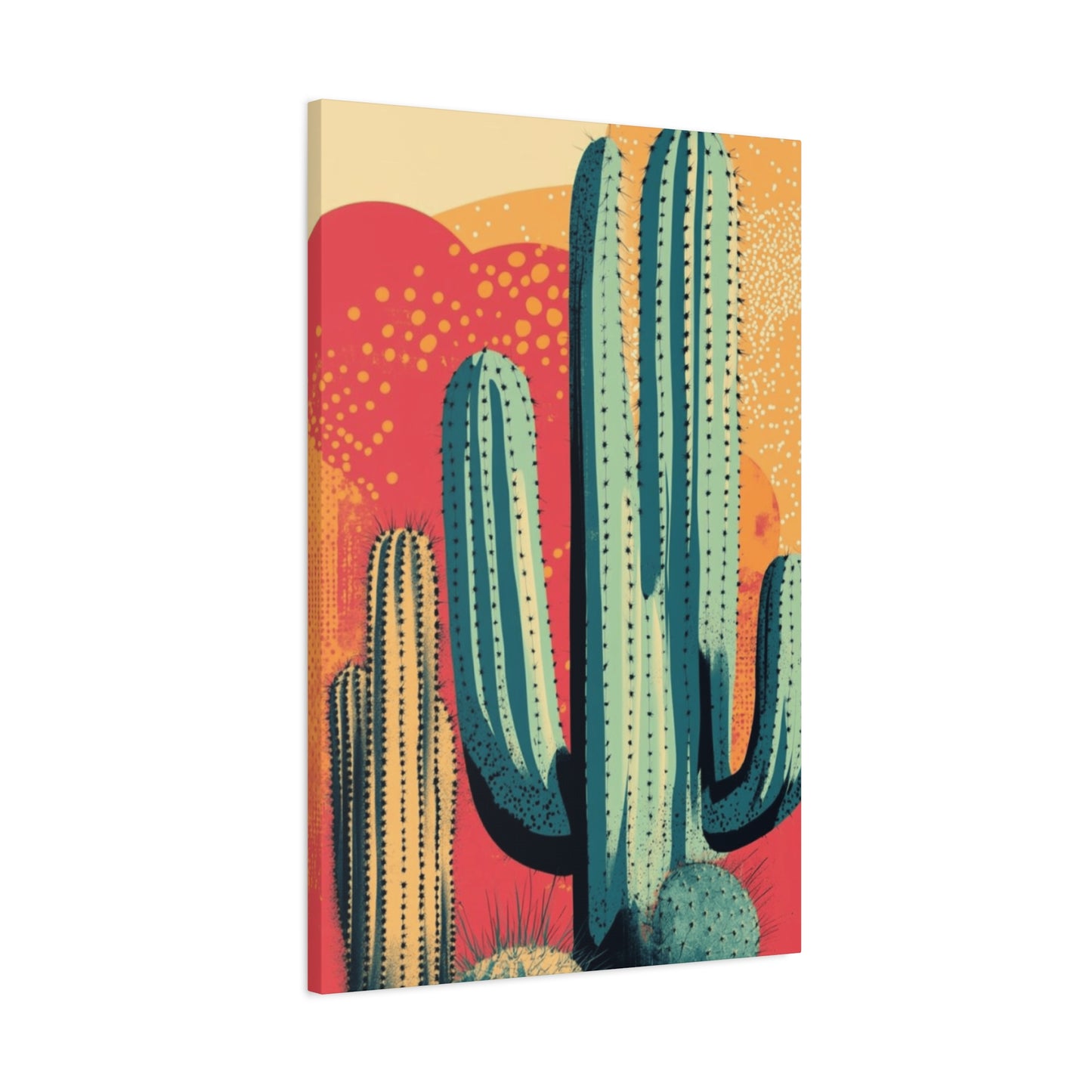Desert Vibes: Using Bright Cactus Painting Wall art to Create a Relaxing Atmosphere
The world of interior decoration has witnessed a remarkable surge in botanical-themed artwork, with desert plant imagery emerging as a particularly captivating choice for contemporary living spaces. Among these natural subjects, the luminous cactus has captured the imagination of designers and homeowners alike, offering a perfect blend of organic beauty and modern aesthetics. Canvas prints featuring these resilient plants bring an element of nature indoors while maintaining a sophisticated edge that complements various design philosophies.
Desert flora artwork represents more than mere decoration; it embodies a lifestyle choice that celebrates minimalism, sustainability, and the raw beauty of nature's most adaptive specimens. The appeal of these striking plants lies in their unique forms, unexpected colors, and the sense of serenity they convey. When translated onto canvas, these characteristics create powerful visual statements that can anchor a room's design scheme or serve as conversation-starting focal points.
The versatility of cactus-themed canvas displays makes them suitable for virtually any interior setting, from residential homes to commercial establishments. Their ability to bridge the gap between natural elements and contemporary design sensibilities has made them increasingly popular among those seeking to create spaces that feel both current and timeless. The dimensional quality of canvas prints adds depth and texture to walls, transforming flat surfaces into dynamic features that engage viewers and enhance spatial dynamics.
The Rising Popularity of Desert Plant Imagery in Modern Interiors
Contemporary interior design has embraced botanical elements with unprecedented enthusiasm, and desert plant imagery stands at the forefront of this movement. The shift toward incorporating natural motifs reflects a broader cultural trend emphasizing biophilic design principles, which recognize the human need for connection with nature even within built environments. Desert plants, with their sculptural qualities and minimalist forms, satisfy this desire while maintaining a clean, uncluttered aesthetic that resonates with modern sensibilities.
The psychological impact of incorporating natural imagery into living spaces cannot be overstated. Research in environmental psychology has demonstrated that exposure to natural elements, even in representational form, can reduce stress levels, enhance mood, and improve overall wellbeing. Desert plant artwork offers these benefits while introducing visual interest through bold shapes, unexpected color combinations, and intriguing textures that stimulate the mind without overwhelming the senses.
The democratization of art through accessible canvas printing technology has made high-quality botanical artwork available to a broader audience than ever before. What was once the exclusive domain of fine art collectors has become attainable for everyday decorators seeking to elevate their spaces. This accessibility has fueled the popularity of desert plant imagery, allowing individuals to express their personal style and connection to nature without significant financial investment.
Urban dwellers particularly gravitate toward these representations of resilient flora, perhaps as a counterpoint to the concrete landscapes they navigate daily. The cactus, thriving in harsh conditions with minimal resources, serves as both aesthetic choice and symbolic statement about adaptability and strength. This deeper meaning adds layers of significance to what might initially appear as simple decorative choices, creating emotional connections between occupants and their environments.
Understanding Canvas Print Quality and Material Composition
The foundation of any exceptional wall artwork lies in the quality of materials used in its creation. Canvas prints designed for longevity and visual impact require careful consideration of fabric composition, printing techniques, and finishing processes. The substrate itself typically consists of either cotton, polyester, or a blend of both materials, each offering distinct characteristics that affect the final appearance and durability of the artwork.
Cotton canvas provides a traditional feel with natural texture that many artists and collectors prefer for its authentic appearance. The material accepts ink beautifully, allowing for rich color saturation and subtle tonal variations that bring depth to printed images. High-grade cotton canvas features a tight weave that prevents ink bleeding and maintains image sharpness, ensuring that fine details in desert plant artwork remain crisp and clear over time. The natural fibers also contribute to the artwork's overall aesthetic, adding an element of organic authenticity that complements botanical subjects.
Polyester canvas offers different advantages, particularly regarding durability and color retention. This synthetic material resists moisture, mildew, and environmental degradation more effectively than natural fibers, making it ideal for locations with varying humidity levels or challenging display conditions. The smooth surface of polyester canvas can produce exceptionally sharp images with vibrant colors that maintain their intensity for extended periods. For desert plant artwork featuring bold hues and stark contrasts, polyester's ability to hold vivid pigments makes it an excellent choice.
Blended canvas materials attempt to combine the best characteristics of both natural and synthetic fibers. These hybrid substrates offer the textural appeal of cotton with the enhanced durability of polyester, creating a balanced option that satisfies both aesthetic and practical requirements. The specific ratio of cotton to polyester in blended canvas affects its performance characteristics, with higher cotton content providing more traditional texture and increased polyester content offering greater longevity.
The weight and thickness of canvas material significantly impact the final product's quality and presentation. Measured in ounces per square yard or grams per square meter, canvas weight indicates both the physical substance of the material and its ability to maintain structural integrity when stretched over frames. Heavier canvas typically resists warping and sagging better than lighter alternatives, ensuring that artwork maintains its taut, professional appearance throughout its lifespan. For large-format cactus prints, substantial canvas weight becomes particularly important to prevent distortion that might compromise the visual impact of bold, graphic designs.
Printing Technologies That Bring Desert Flora to Life
The method used to transfer images onto canvas fundamentally determines the quality, longevity, and visual characteristics of the final artwork. Modern printing technologies have evolved to offer unprecedented accuracy in color reproduction, detail preservation, and archival stability, ensuring that desert plant artwork maintains its vibrancy and clarity for decades. Understanding these technologies helps consumers make informed decisions when selecting canvas prints for their spaces.
Giclée printing represents the gold standard in fine art reproduction, utilizing sophisticated inkjet technology to achieve museum-quality results. This process employs specialized printers capable of delivering millions of color variations through multiple ink cartridges, often including eight or more individual colors beyond the standard cyan, magenta, yellow, and black configuration. The expanded color gamut enables precise reproduction of subtle color gradations found in nature, capturing the nuanced greens of cacti, the delicate tints of flowers, and the warm tones of desert backgrounds with remarkable fidelity.
The microscopic droplet size produced by giclée printers ensures smooth color transitions without visible banding or pixelation, even when viewed at close range. This characteristic proves particularly valuable for large-format desert plant artwork, where viewers may examine details from varying distances. The consistency and precision of giclée printing allows for faithful reproduction of photographic images or original artwork, preserving the artist's vision and the natural beauty of the subject matter.
Archival pigment inks form an essential component of premium canvas printing, offering superior longevity compared to dye-based alternatives. These specialized inks contain pigment particles suspended in carrier fluids, creating colorants that resist fading from ultraviolet light exposure, environmental pollutants, and general aging processes. When combined with appropriate canvas materials and protective coatings, pigment-based prints can maintain their original appearance for over a century under normal display conditions, making them genuine investment pieces rather than temporary decorations.
The chemical stability of pigment inks ensures that the vivid colors characteristic of quality desert plant artwork remain true over time. The greens stay vibrant, the earth tones maintain their warmth, and any accent colors retain their intensity without shifting toward unwanted hues. This longevity proves particularly important for those who view their art collection as a long-term investment in their living environment rather than a disposable element subject to frequent replacement.
Desert Plant Wall Displays
The colors present in desert plant artwork exert profound psychological and emotional effects on space occupants, influencing mood, energy levels, and overall environmental perception. Understanding these color dynamics enables more intentional selection of artwork that supports desired atmospheric qualities within specific rooms or functional areas. The palette typically associated with cactus imagery spans from soothing earth tones to vibrant accent hues, each contributing distinct psychological impacts.
Green, the predominant color in most plant life, carries powerful associations with growth, renewal, and natural harmony. In interior environments, green tones promote feelings of balance and tranquility, creating spaces that feel restorative and calm. The particular shades of green found in cacti range from pale sage to deep forest, with many species displaying blue-green or gray-green variations that introduce sophisticated complexity to the color story. These cooler green tones particularly suit spaces designated for relaxation or concentration, as they encourage mental clarity without stimulating excessive activity.
The presence of green in living spaces has been linked to improved focus and reduced eye strain, making cactus artwork particularly appropriate for home offices or study areas. The color's connection to nature triggers innate responses that lower stress hormones and promote feelings of security, effects that persist even when green appears in representational form rather than living plants. For those unable to maintain live specimens due to lifestyle constraints or environmental conditions, green-hued canvas prints offer many of the same psychological benefits.
Warm accent colors frequently appear in desert plant imagery through flowers, spines, or background elements, introducing energy and visual interest to compositions. Coral, pink, yellow, and orange tones inject vitality into spaces, stimulating conversation and creative thinking. These warm hues counterbalance the cooling effects of green, creating dynamic visual tension that engages viewers and prevents monotony. The strategic use of warm accents in predominantly green compositions mirrors the surprising bursts of color found in actual desert landscapes, where brilliant blooms emerge unexpectedly from seemingly monochromatic scenery.
Earth tones forming backgrounds or surrounding elements in desert plant artwork contribute grounding effects that anchor compositions and create cohesive color schemes. Browns, tans, beiges, and terracotta shades evoke natural materials and connect interior spaces to the organic world. These neutral foundations allow the more vibrant elements of cactus imagery to shine without competing for attention, establishing visual hierarchies that guide the viewer's eye through the composition. The warmth of earth tones creates inviting atmospheres that feel comfortable and lived-in rather than sterile or cold.
Selecting Appropriate Sizes for Maximum Visual Impact
The dimensions of canvas artwork dramatically affect its presence within a space and its ability to fulfill intended decorative functions. Choosing appropriate sizes requires consideration of wall dimensions, furniture scale, viewing distances, and the desired level of visual dominance. Desert plant artwork benefits from thoughtful size selection that allows its graphic qualities and natural beauty to register properly without overwhelming or disappearing within the surrounding environment.
Large-scale canvas prints create powerful focal points that command attention and anchor room designs. Oversized cactus imagery works particularly well on expansive walls where substantial visual weight is needed to balance architectural features or large furniture pieces. The bold, sculptural forms of desert plants lend themselves naturally to large format presentation, as their simplified shapes and strong silhouettes maintain clarity and impact even at significant sizes. A single large canvas featuring dramatic cactus specimens can eliminate the need for additional wall decorations, providing sufficient visual interest to carry the entire design scheme.
The relationship between artwork size and furniture dimensions requires careful calibration to achieve harmonious proportions. A general guideline suggests that artwork displayed above furniture should measure approximately two-thirds to three-quarters the width of the furniture piece below it. This proportion creates visual balance without appearing either lost above a substantial sofa or comically oversized above a delicate console table. For cactus canvas prints positioned above seating areas, maintaining these proportions ensures the artwork feels intentionally scaled rather than arbitrarily placed.
Medium-sized canvas prints offer versatility for various display scenarios, working equally well as standalone pieces or components within gallery wall arrangements. Dimensions in the range of twenty-four to forty inches allow desert plant artwork to establish presence without demanding complete visual dominance. These intermediate sizes suit rooms where multiple focal points share attention or where artwork needs to complement rather than compete with other design elements. Medium canvases also provide flexibility for future redesigns, as their moderate scale adapts more readily to different spatial configurations than extremely large or small pieces.
Small canvas prints serve important roles in layered, collected arrangements or as accent pieces that add personality to intimate spaces. Compact cactus images work beautifully in gallery walls where multiple pieces combine to create cohesive visual statements, with individual components contributing to an overall narrative. Small-scale artwork also suits tight spaces like powder rooms, corridors, or small office areas where larger pieces would overwhelm. The key to successfully employing small canvases lies in clustering them intentionally rather than scattering them randomly, creating purposeful groupings that register as unified design elements.
Framing Options That Enhance Desert Plant Presentations
The manner in which canvas prints are finished and presented significantly influences their aesthetic impact and integration within interior designs. While canvas artwork offers the unique advantage of frameless presentation through gallery wrapping techniques, various framing options exist to suit different aesthetic preferences and functional requirements. Understanding these presentation methods enables selection of finishes that enhance rather than detract from the natural beauty of desert plant imagery.
Gallery wrap construction represents the most popular contemporary presentation method for canvas prints, eliminating traditional frames entirely while creating polished, finished edges. This technique involves stretching printed canvas around wooden stretcher bars, with the image continuing around the sides of the frame for a three-dimensional effect. The wrapped edges create visual depth that enhances the sculptural qualities already present in cactus imagery, emphasizing the dimensional aspects of the printed plants. Gallery wraps present clean, modern profiles that suit minimalist and contemporary design schemes while maintaining focus on the artwork itself rather than decorative framing.
The depth of stretcher bars affects the visual presence and shadow lines created by gallery-wrapped canvas. Standard depths of three-quarters to one inch provide modest dimension suitable for most applications, while deeper stretcher bars measuring one and one-half inches or more create dramatic shadows and pronounced three-dimensional effects. For large-format desert plant artwork, deeper stretcher bars prevent the canvas from appearing thin or insubstantial, providing physical weight that matches the visual impact of bold imagery. The choice between standard and deep gallery wraps depends on desired aesthetic effects and the overall design approach of the space.
Traditional wood frames offer alternative presentation methods that introduce additional colors, textures, and visual weight to canvas artwork. Natural wood frames with visible grain patterns complement the organic subject matter of desert plants, creating cohesive relationships between content and presentation. Light woods like maple, oak, or pine contribute casual, approachable qualities, while darker woods such as walnut or espresso-stained frames add sophistication and drama. The width of wood frames affects their visual prominence, with narrow moldings providing subtle definition and wider frames creating more substantial borders that can either enhance or compete with the artwork itself.
Metal frames introduce contemporary, industrial aesthetics that pair surprisingly well with botanical subjects, creating intriguing contrasts between natural content and modern presentation. Sleek aluminum frames in brushed, polished, or powder-coated finishes add architectural precision to canvas prints, emphasizing their role as designed elements within curated spaces. Black metal frames offer versatile neutrality that works across various color schemes, while brass, copper, or gold-toned metals introduce warmth and luxury. For desert plant artwork featuring cool tones or minimalist compositions, metal frames can provide complementary structure without adding visual clutter.
Floating frames create sophisticated presentations where canvas appears suspended within the frame structure, with visible gaps between the artwork edges and frame interior. This mounting technique highlights the canvas as a precious object worthy of special treatment while adding architectural interest through layered dimensions. Floating frames work particularly well for desert plant artwork with interesting side treatments, as the gap reveals the wrapped edges and emphasizes the three-dimensional nature of the canvas construction. The shadows created by floating mounts add depth and drama, transforming wall surfaces from flat planes into dynamic displays.
Strategic Placement for Optimal Viewing Experience
The location where canvas artwork is installed dramatically affects its visibility, impact, and integration within overall room designs. Strategic placement considers factors including natural and artificial lighting, traffic patterns, sightlines, and functional requirements of specific spaces. Desert plant artwork benefits from thoughtful positioning that allows its colors, textures, and compositions to be appreciated while supporting the intended use of each room.
Lighting conditions fundamentally influence how artwork appears and whether its colors and details can be properly appreciated. Natural light streaming through windows can illuminate canvas prints beautifully during daylight hours, though direct sunlight should be avoided to prevent premature fading and damage to both canvas and inks. Positioning desert plant artwork on walls perpendicular to windows allows natural illumination without direct exposure, creating ideal viewing conditions that change throughout the day as light angles shift. For spaces lacking abundant natural light, dedicated picture lighting or well-positioned ambient fixtures ensure artwork remains visible and impactful during evening hours.
The height at which canvas prints are hung affects viewing comfort and overall room proportion. Professional gallery standards suggest positioning artwork so that its center point falls approximately fifty-seven to sixty inches from the floor, aligning with average eye level for standing viewers. This guideline works well for most applications, though adjustments may be necessary based on ceiling height, furniture arrangement, and whether the space is primarily experienced while standing or seated. In dining rooms or bedrooms where occupants spend considerable time seated, lowering artwork slightly ensures comfortable viewing from these positions.
Relationship to furniture and architectural features requires careful consideration when placing desert plant canvas prints. Artwork positioned above sofas, beds, or console tables should relate proportionally to these anchor pieces, typically centering above them while maintaining appropriate scale relationships. In rooms with prominent architectural elements like fireplaces, built-in shelving, or distinctive molding, canvas prints can either highlight these features by drawing attention toward them or provide counterbalancing focal points that distribute visual interest throughout the space. The goal is creating intentional relationships rather than random placements that feel disconnected from the overall design composition.
Traffic flow and functional clearances influence where artwork can practically be displayed without risking damage or creating spatial conflicts. High-traffic areas like hallways benefit from canvas prints that add visual interest without protruding significantly from walls, making gallery-wrapped options particularly suitable. In contrast, rooms where movement is more constrained allow for deeper frames or floating mounts that extend further from wall surfaces. Door swing clearances, furniture accessibility, and movement patterns all factor into determining appropriate locations for displaying desert plant artwork without compromising room functionality.
Creating Cohesive Gallery Wall Arrangements
Multiple canvas prints can be combined into curated collections that create more complex visual statements than single pieces alone. Gallery wall arrangements allow for creative expression through the selection, organization, and display of related artworks that together tell stories or establish thematic connections. Desert plant imagery lends itself beautifully to gallery wall treatments, as the variety of cactus species, perspectives, and color variations provide ample material for developing cohesive yet diverse collections.
Thematic consistency forms the foundation of successful gallery walls, ensuring that individual pieces feel related even when they differ in specific content or composition. For desert plant collections, thematic unity might derive from shared color palettes, similar graphic styles, consistent perspectives, or representation of different species within the same botanical family. The common thread running through the collection creates visual harmony while the variations between individual pieces maintain interest and prevent monotony. Establishing clear thematic parameters before selecting artwork prevents arbitrary assemblages that lack intentional direction.
Grid layouts provide structured, orderly approaches to arranging multiple canvas prints, particularly effective for collections where individual pieces share similar sizes and proportions. Symmetrical grid arrangements convey formality and precision, creating sense of deliberate curation that suits traditional or contemporary-formal design schemes. The regular spacing and alignment of grid layouts establish visual rhythm that feels calm and organized, allowing viewers to appreciate each piece individually while understanding its contribution to the larger whole. For desert plant collections featuring consistent image treatments or matching frame styles, grid arrangements maximize impact through unified presentation.
Salon-style arrangements embrace asymmetry and varied spacing, creating more casual, organic compositions that feel collected over time rather than purchased as complete sets. This approach allows mixing of different canvas sizes, frame styles, and image orientations, building visual complexity through intentional disorder. The key to successful salon walls lies in maintaining some organizing principle despite apparent randomness, whether through consistent spacing between pieces, alignment of certain edges, or strategic distribution of sizes and visual weights. Desert plant artwork adapts well to salon-style presentations, as the varied forms and scales of different cactus species naturally create interesting visual rhythms when combined.
Central anchor pieces provide focal points around which supporting artworks orbit in constellation-style arrangements. This approach establishes clear hierarchies within gallery walls, guiding viewer attention while creating structured compositions that feel balanced despite asymmetrical layouts. The anchor typically consists of the largest or most visually striking piece in the collection, positioned centrally with smaller complementary pieces arranged around it at varied distances and relationships. For desert plant collections, a dramatic large-format cactus image might serve as the anchor, surrounded by smaller prints featuring detail views, different species, or related desert landscape elements.
Horizontal or vertical emphasis in gallery wall arrangements affects how collections interact with room proportions and architectural features. Horizontally oriented layouts extend across walls, creating panoramic effects that draw the eye laterally and can make rooms feel wider. These arrangements work particularly well above long furniture pieces like sofas or credenzas, visually connecting multiple elements into unified compositions. Vertically oriented arrangements emphasize height, drawing attention upward and making spaces feel taller. Vertical gallery walls suit narrow wall sections between windows or doors, taking advantage of limited width by building compositions upward rather than across.
Color Coordination with Existing Interior Palettes
Integrating desert plant canvas prints into established color schemes requires understanding both the artwork's inherent palette and the surrounding interior colors. Successful coordination creates harmonious environments where artwork feels naturally connected to its setting rather than arbitrarily inserted. The flexibility of cactus imagery, with its range from subdued earth tones to vibrant accent colors, allows for various approaches to color integration depending on desired effects.
Monochromatic schemes employ variations of a single color family, creating sophisticated, cohesive environments through subtle tonal shifts rather than contrasting hues. Desert plant artwork can support monochromatic interiors by introducing texture and form while maintaining color discipline. A room designed around various shades of green, for instance, might incorporate cactus canvas prints featuring sage, olive, emerald, and lime tones that reinforce the chosen palette while adding natural subject matter. The visual interest comes from variations in saturation, brightness, and texture rather than color diversity, resulting in calm, unified spaces that feel intentionally designed.
Analogous color schemes combine colors that sit adjacent to each other on the color wheel, creating harmonious relationships through natural progressions. Desert plant artwork featuring greens paired with blue-greens, yellow-greens, or green-yellows exemplifies analogous coordination, introducing gentle color movement while maintaining cohesion. These schemes feel naturally balanced and easy on the eye, as the colors share common components that create visual flow. For interiors designed around warm analogous palettes, cactus prints featuring yellow-greens paired with yellows and oranges can reinforce the color strategy while introducing botanical elements.
Complementary schemes employ colors opposite each other on the color wheel, creating dynamic visual tension through high contrast. Green cacti paired with red or coral accents, or blue-green plants against warm orange backgrounds, exemplify complementary relationships that energize spaces through color opposition. These bold combinations demand careful balance to prevent overwhelming sensory experiences, typically achieved by allowing one color to dominate while using its complement in smaller doses for accent. Desert plant artwork naturally provides opportunities for complementary schemes, as many cactus flowers display colors that contrast beautifully with the plant's foliage.
Neutral foundations provide versatile backgrounds that allow desert plant artwork to establish the primary color direction in spaces. Rooms dominated by whites, grays, beiges, or other neutral tones benefit from artwork that introduces controlled color without committing the entire space to specific palettes. Cactus canvas prints can inject needed vitality into neutral environments, whether through verdant greens that bring life to gray rooms or warm earth tones that add comfort to all-white spaces. The neutrality of the surrounding environment ensures that artwork receives appropriate visual emphasis, functioning as both color source and focal point.
Protecting Canvas Artwork Longevity
Proper care and maintenance significantly extend the lifespan of canvas prints, ensuring that desert plant artwork maintains its beauty and impact for decades. Understanding the factors that degrade canvas and inks enables implementation of protective measures that preserve investment while enjoying artwork daily. Most canvas care involves preventive actions rather than active maintenance, making preservation relatively simple for those who understand basic principles.
Environmental control represents the most important factor in canvas preservation, as extreme conditions accelerate deterioration of both substrate and printed images. Temperature fluctuations cause expansion and contraction of canvas fibers and wooden stretcher bars, potentially leading to warping, cracking, or separation of canvas from frame. Maintaining stable temperatures between sixty-five and seventy-five degrees Fahrenheit minimizes these physical stresses. Similarly, humidity levels significantly affect canvas condition, with excessive moisture promoting mold growth and fiber degradation while extreme dryness causes brittleness and cracking. Relative humidity between forty and fifty-five percent provides optimal conditions for canvas preservation.
Light exposure, particularly ultraviolet radiation, represents one of the most significant threats to canvas artwork longevity. UV light breaks down chemical bonds in both pigments and canvas fibers, causing fading, discoloration, and material weakening. While some light exposure is inevitable in display scenarios, minimizing direct sunlight and utilizing UV-filtering glazing or protective coatings dramatically slows degradation. For desert plant artwork displayed in sun-filled rooms, positioning away from direct light paths or adding window treatments that filter UV radiation protects investment without sacrificing visibility. Artificial lighting should employ LED fixtures that emit minimal UV radiation compared to traditional incandescent or fluorescent sources.
Protective coatings applied to canvas surfaces provide additional defenses against environmental damage, physical contact, and atmospheric pollutants. Clear acrylic or polymer varnishes create barrier layers that shield printed surfaces from dust accumulation, moisture absorption, and minor impacts that might otherwise mar the image. These protective treatments also enhance color saturation and contrast, often making prints appear more vibrant while simultaneously extending their lifespan. Professional-quality protective coatings should be factory-applied or added by experienced framers to ensure even coverage without bubbling, streaking, or texture alteration.
Cleaning procedures for canvas prints must be gentle to avoid damaging printed surfaces or canvas fibers. Regular dusting using soft, dry cloths or feather dusters removes accumulated particulates without introducing moisture or abrasion. For deeper cleaning needs, specialized canvas cleaning products designed for printed artwork should be employed following manufacturer instructions carefully. Aggressive cleaning methods, harsh chemicals, or excessive water application can cause irreversible damage to both canvas and inks, making conservative approaches advisable. When significant soiling or damage occurs, professional art conservators possess the expertise and tools to clean or restore canvas artwork without causing further deterioration.
Seasonal Rotation Strategies for Dynamic Interiors
Rotating displayed artwork according to seasons or personal inclination refreshes interior environments while extending the effective lifespan of canvas prints by limiting continuous light exposure. This curatorial approach transforms homes into dynamic spaces that evolve throughout the year, maintaining visual interest and preventing design fatigue. Desert plant artwork adapts well to rotational strategies, as different pieces can emphasize seasonal qualities or complement shifting decorative schemes.
Seasonal color associations guide artwork selection for different times of year, creating subtle connections between interior environments and external seasonal changes. Spring rotations might favor desert plant prints featuring fresh greens and delicate flower blooms, echoing renewal and growth themes associated with the season. Summer displays could emphasize vibrant, saturated colors and bold compositions that mirror the intensity of long, bright days. Autumn rotations might introduce warmer earth tones and more subdued palettes that harmonize with harvest season aesthetics, while winter displays could feature cool-toned cactus imagery or minimalist compositions that reflect dormancy and introspection.
Storage conditions for rotated artwork require attention to prevent damage during non-display periods. Canvas prints should be stored in climate-controlled environments with stable temperature and humidity levels, avoiding attics, basements, or garages where conditions fluctuate dramatically. Stored artwork benefits from protective covering using acid-free materials that prevent dust accumulation without trapping moisture against canvas surfaces. Vertical storage positioning prevents warping from stacking weight while protecting canvas from accidental impacts. For those who rotate artwork regularly, dedicated storage systems like canvas racks or padded bags designed specifically for artwork protection justify investment through improved preservation and organization.
Documentary practices help track artwork locations, condition, and rotation schedules, particularly valuable for larger collections where memory alone proves insufficient. Simple databases or spreadsheets recording acquisition dates, dimensions, storage locations, and display history enable efficient management of rotating collections. Photographic documentation of how pieces look when properly displayed provides references for future installations, ensuring consistent presentation standards. These organizational systems prevent artwork from being forgotten in storage while facilitating intentional curation that considers overall collection balance when selecting pieces for display.
Psychological benefits of artwork rotation extend beyond aesthetic refreshment, as changing visual environments stimulate mental engagement and prevent habituation that causes displayed pieces to become invisible through over-familiarity. The anticipation of seasonal changes and the ritual of selecting and installing different artworks create meaningful interactions with collections that deepen appreciation. For desert plant artwork, rotation allows engagement with various species, compositions, and color palettes throughout the year, preventing any single piece from becoming stale while maintaining ongoing discovery within owned collections.
Complementary Decorative Elements for Botanical Themes
Desert plant canvas prints achieve maximum impact when integrated with complementary decorative elements that reinforce botanical themes while maintaining design cohesion. Thoughtful selection of supporting accessories, textiles, and accent pieces creates layered, sophisticated interiors where multiple elements work synergistically rather than competing for attention. The key lies in balance, ensuring that botanical themes feel intentionally developed without becoming heavy-handed or literal.
Textile selections offer opportunities to echo colors, patterns, or themes present in desert plant artwork while adding softness and tactile variety to interior environments. Throw pillows featuring botanical prints or solid colors drawn from cactus canvas palettes create visual connections between artwork and furnishings. Natural fiber textiles like linen, cotton, and jute complement organic subject matter while introducing textural interest that enhances sensory richness. For desert-themed interiors, woven textiles with geometric patterns inspired by Native American designs or contemporary interpretations of desert landscapes strengthen thematic connections while avoiding literal botanical repetition.
Living plants provide the most direct complement to desert plant artwork, bringing three-dimensional botanical elements into dialogue with two-dimensional representations. For those unable or unwilling to care for actual cacti and succulents, low-maintenance alternatives like pothos, snake plants, or ZZ plants offer similar organic presence with less demanding care requirements. The combination of living plants and botanical artwork creates layered nature references that satisfy biophilic design principles while adding life and movement to static spaces. Strategic placement of potted plants near or beneath cactus canvas prints establishes visual relationships that feel natural and intentional rather than coincidental.
Sculptural objects and decorative accessories can reinforce desert or botanical themes through material choices, forms, or cultural references. Ceramic vessels with organic shapes and earthy glazes echo the natural world while providing functional storage or display purposes. Wooden bowls, stone objects, or metalwork with nature-inspired designs add three-dimensional interest that complements flat canvas prints. For rooms featuring multiple desert plant artworks, judicious use of supporting accessories prevents thematic overload through restraint, selecting only pieces that genuinely enhance rather than merely repeat the botanical concept.
Furniture selections influence how botanical artwork integrates within overall design schemes, with certain styles and materials naturally complementing desert plant themes more effectively than others. Mid-century modern furniture with clean lines and organic forms pairs beautifully with cactus imagery, creating cohesive environments that feel both retro and contemporary. Natural wood furniture emphasizes connections to organic materials, though style and finish must coordinate with the artwork's aesthetic for harmonious results. Conversely, deliberately contrasting furniture styles can create interesting tension with botanical artwork, as when ornate traditional pieces provide counterpoint to minimalist cactus prints, generating visual dialogue through opposition.
Room-Specific Application Strategies
Different spaces within homes serve distinct functions and create varied opportunities for displaying desert plant canvas prints. Understanding room-specific requirements enables artwork selection and placement that supports intended uses while enhancing aesthetic appeal. The versatility of cactus imagery allows appropriate application across diverse settings, from private retreats to public gathering spaces.
Living rooms function as primary gathering spaces where families and guests spend considerable time, making them ideal locations for statement desert plant artwork that establishes design direction. Large-scale canvas prints can anchor seating arrangements, providing focal points that ground furniture groupings while adding personality and visual interest. The colors and moods conveyed by cactus artwork influence the overall atmosphere of living spaces, with energizing pieces promoting conversation and interaction while calmer compositions encourage relaxation. Multiple canvas prints arranged in gallery walls can fill substantial wall expanses in large living rooms, creating custom installations that feel collected and intentional.
Bedrooms benefit from desert plant artwork that promotes tranquility and connection with nature, supporting the room's primary function as a restorative retreat. Positioning canvas prints where they're visible from the bed creates focal points for morning and evening contemplation, beginning and ending days with natural beauty. The predominantly green palettes of many cactus images support relaxation through their psychological associations with balance and harmony. For bedrooms with neutral color schemes, botanical canvas prints introduce controlled color that enlivens spaces without creating overstimulating environments incompatible with rest.
Dining spaces accommodate desert plant artwork that enhances the enjoyment of meals while withstanding proximity to food preparation and service activities. Canvas prints in dining rooms should be positioned to avoid splatters from serving areas while remaining visible to seated diners. The subjects and styles of cactus artwork in dining contexts can range from elegant botanical illustrations that lend formal sophistication to casual, graphic prints that create relaxed, contemporary atmospheres. The colors in dining room artwork ideally complement table settings and dining furniture, creating cohesive environments where all elements work harmoniously.
Home offices require artwork that supports productivity while maintaining visual interest during long work hours. Desert plant canvas prints introduce nature references that reduce stress and mental fatigue associated with sustained concentration. The symbolic associations of cacti with resilience and adaptation may provide subliminal encouragement during challenging work tasks. Positioning artwork at eye level when looking up from computer screens provides natural break points that encourage periodic visual rest, combating digital eye strain. For video conference backgrounds, carefully positioned botanical canvas prints create professional yet personalized settings that project sophistication and attention to design detail.
Bathrooms accommodate smaller desert plant artworks that add personality to functional spaces often neglected in decorating schemes. The moisture-resistant properties of properly sealed canvas prints enable bathroom display, though direct exposure to shower spray should be avoided. Botanical themes feel naturally appropriate in bathrooms, spaces associated with personal care and rejuvenation. Compact cactus prints can transform powder rooms into memorable spaces that make positive impressions on guests, demonstrating attention to detail throughout the home.
Hallways and transitional spaces benefit from desert plant artwork that maintains visual interest in areas typically traversed rather than occupied. Narrow corridors accommodate vertical gallery walls or horizontal series of similarly sized prints that create rhythm and movement along circulation paths. The simplified forms and bold graphics of many cactus images remain legible even when viewed in passing, making them suitable for hallway display where detailed compositions might go unappreciated. Consistent artwork themes in hallways can unify separate rooms, creating visual continuity that improves spatial flow.
Budget Considerations and Value Assessment
Canvas print pricing varies dramatically based on size, quality, printing method, and finishing options, requiring informed evaluation to ensure appropriate value for expenditure. Understanding cost factors enables budget-conscious shoppers to make strategic choices that maximize quality within financial constraints while avoiding unnecessary expenses for features that don't meaningfully improve outcome. Desert plant artwork exists at every price point, from economical mass-produced prints to investment-grade limited editions.
Print production methods significantly impact pricing, with giclée and other high-end processes commanding premium prices justified by superior color accuracy, longevity, and detail preservation. For those prioritizing archival quality and long-term display, the additional cost of premium printing methods represents worthwhile investment that amortizes over decades of enjoyment. Conversely, temporary displays or frequently changed artwork may not justify top-tier printing investment, making economical options appropriate. Understanding personal priorities regarding permanence and quality guides appropriate production method selection.
Size relationships to pricing aren't strictly linear, as economies of scale and production efficiency influence per-square-inch costs. Very large canvas prints may carry disproportionate premiums due to specialized equipment requirements and increased material costs. Similarly, very small prints may not receive corresponding price reductions, as certain production and handling costs remain constant regardless of size. The sweet spot for value often falls in medium size ranges where production processes are most efficient and material costs remain reasonable relative to finished product.
Frame and finishing selections dramatically affect total costs, with elaborate frames potentially exceeding the price of canvas prints themselves. Gallery-wrapped presentations offer cost-effective alternatives to traditional framing while providing contemporary aesthetics that suit modern interiors. For those attracted to framed presentations, selecting simpler moldings and standard sizes reduces custom framing expenses that quickly escalate with unusual dimensions or elaborate frame designs. Some retailers offer complete packages with coordinated frames at bundled prices that provide better value than purchasing components separately.
Conclusion
Incorporating bright cactus painting wall art into your home décor is more than just a design choice; it's an invitation to bring the calming essence of the desert into your living space. The distinctive colors, textures, and forms of cactus plants evoke a serene, tranquil energy that can transform any room into a peaceful retreat. The desert, with its wide-open spaces, warm hues, and unique flora, offers a sense of stillness and connection to nature. Through the use of vibrant cactus wall art, you can recreate these desert vibes and make your home feel like an oasis of relaxation.
Bright cactus paintings bring together various visual elements—bold colors, geometric shapes, and natural forms—that work in harmony to provide a sense of peace and balance. The use of soft greens, yellows, pinks, and oranges can infuse warmth into a room, while the cactus plants themselves often symbolize resilience and adaptability, offering subtle reminders to stay grounded and calm in the face of life’s challenges. These elements come together to create a visual representation of nature’s beauty and strength, both of which are key aspects of achieving relaxation and inner peace.
A significant advantage of cactus wall art is its versatility in adapting to different design styles. Whether your home décor leans toward minimalism, bohemian, or even Southwestern, cactus paintings can seamlessly blend into various aesthetics, creating an effortlessly relaxing atmosphere. In minimalist spaces, the simple yet impactful imagery of a cactus painting can stand as a focal point, bringing life and character to the room without overwhelming it. In more eclectic or boho-inspired interiors, the colorful and dynamic nature of cactus art can add a playful yet soothing energy, enhancing the space’s vibe.
Furthermore, cactus paintings work well in both small and large spaces, adding a touch of nature to rooms with limited natural light or infusing bright color into larger, airier rooms. Whether placed in a living room, bedroom, or even a home office, cactus artwork can serve as a peaceful backdrop to daily activities, whether you’re relaxing, working, or entertaining. The warm tones associated with the desert landscape also have the effect of making a room feel more inviting and cozy, contributing to a sense of safety and comfort.
Beyond aesthetics, cactus wall art can enhance emotional well-being by offering an escape into nature. Art has been proven to positively impact mood and mental health, and by surrounding yourself with imagery of desert landscapes and cacti, you are reminded of nature’s therapeutic qualities. In a world that often feels busy and chaotic, creating a space that allows you to pause and recharge is invaluable. Bright cactus paintings can act as visual cues to slow down, breathe deeply, and enjoy the present moment—whether that’s through simply gazing at the art or incorporating mindful décor rituals into your daily routine.
Ultimately, using bright cactus painting wall art to create a relaxing atmosphere in your home is a simple yet effective way to infuse your space with positive energy. It brings the calming and grounding qualities of the desert indoors, offering a beautiful reminder of nature's peaceful rhythms. Whether you’re drawn to the vibrant colors, the minimalist shapes, or the connection to desert landscapes, cactus art can serve as a transformative element that enhances your home's aesthetic and your overall sense of well-being. By thoughtfully integrating cactus paintings into your décor, you create a space that not only looks beautiful but also promotes relaxation, mindfulness, and peace.











